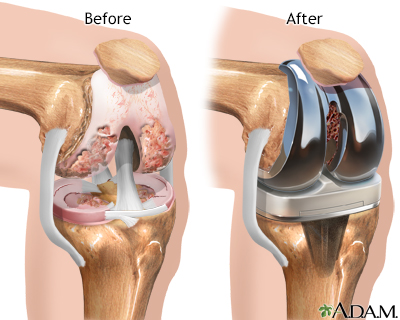Pregnancy SmartSiteTM
Total knee replacement; Knee arthroplasty; Knee replacement - total; Tricompartmental knee replacement; Subvastus knee replacement; Knee replacement - minimally invasive; Knee arthroplasty - minimally invasive; TKA - knee replacement; Osteoarthritis - replacement; OA - knee replacement DefinitionKnee joint replacement is a surgery to replace a knee joint with a man-made artificial joint. The artificial joint is called a prosthesis. DescriptionDamaged cartilage and bone are removed from the knee joint. Man-made pieces are then placed in the knee. These pieces may be placed in the following places in the knee joint:
You will not feel any pain during the surgery. You will have one of these two types of anesthesia:
After you receive anesthesia, your surgeon will make a cut over your knee to open it up. This cut is often 8 to 10 inches (20 to 25 centimeters) long. Then your surgeon will:
The surgery takes about 2 hours. Most artificial knees have both metal and plastic parts. Some surgeons now use different materials, including metal on metal, ceramic on ceramic, or ceramic on plastic. Why the Procedure Is PerformedThe most common reason to have a knee joint replaced is to relieve severe arthritis pain. Your health care provider may recommend knee joint replacement if:
Most of the time, knee joint replacement is done in people age 60 and older. Younger people who have a knee joint replaced may put extra stress on the artificial knee and cause it to wear out early and not last as long. Before the ProcedureAlways tell your provider what medicines you are taking, even medicines, supplements, or herbs you bought without a prescription. During the 2 weeks before your surgery:
On the day of your surgery:
After the ProcedureYou may go home the same day or you may stay in the hospital for 1 to 2 days. During that time, you will recover from your anesthesia and from the surgery itself. You will be asked to start moving and walking as soon as the day of surgery. Full recovery will take 4 months to a year. Some people need a short stay in a rehabilitation center after they leave the hospital and before they go home. At a rehabilitation center, you will learn how to safely do your daily activities on your own. Outlook (Prognosis)The results of a total knee replacement are often excellent. The operation relieves pain for most people. Most people do not need help walking after they fully recover. Over 90 percent of artificial knee joints last over 15 years. Some last as long as 25 years before they loosen and need to be replaced again. Total knee replacements can be replaced again if they get loose or wear out. However, in most cases the results are not as good as the first time. It is important not to have the surgery too early so you will need another surgery at a young age or have it too late when you will not benefit the most. After surgery, you should have periodic checkups with your surgeon to make sure the parts of your artificial joint are in good position and condition. ReferencesAmerican Academy of Orthopedic Surgeons (AAOS) website. Treatment: total knee replacement. orthoinfo.aaos.org/en/treatment/total-knee-replacement. Updated February 2024. Accessed September 26, 2024. Ellen MI, Forbush DR, Groomes TE. Total knee arthroplasty. In: Frontera WR, Silver JK, Rizzo TD Jr, eds. Essentials of Physical Medicine and Rehabilitation. 4th ed. Philadelphia, PA: Elsevier; 2019:chap 80. Mihalko WM. Arthroplasty of the knee. In: Azar FM, Beaty JH, eds. Campbell's Operative Orthopaedics.14th ed. Philadelphia, PA: Elsevier; 2021:chap 7. | ||
| ||
Review Date: 8/27/2024 Reviewed By: C. Benjamin Ma, MD, Professor, Chief, Sports Medicine and Shoulder Service, UCSF Department of Orthopaedic Surgery, San Francisco, CA. Also reviewed by David C. Dugdale, MD, Medical Director, Brenda Conaway, Editorial Director, and the A.D.A.M. Editorial team. View References The information provided herein should not be used during any medical emergency or for the diagnosis or treatment of any medical condition. A licensed medical professional should be consulted for diagnosis and treatment of any and all medical conditions. Links to other sites are provided for information only -- they do not constitute endorsements of those other sites. No warranty of any kind, either expressed or implied, is made as to the accuracy, reliability, timeliness, or correctness of any translations made by a third-party service of the information provided herein into any other language. © 1997- A.D.A.M., a business unit of Ebix, Inc. Any duplication or distribution of the information contained herein is strictly prohibited. | ||


 Knee joint replace...
Knee joint replace...
